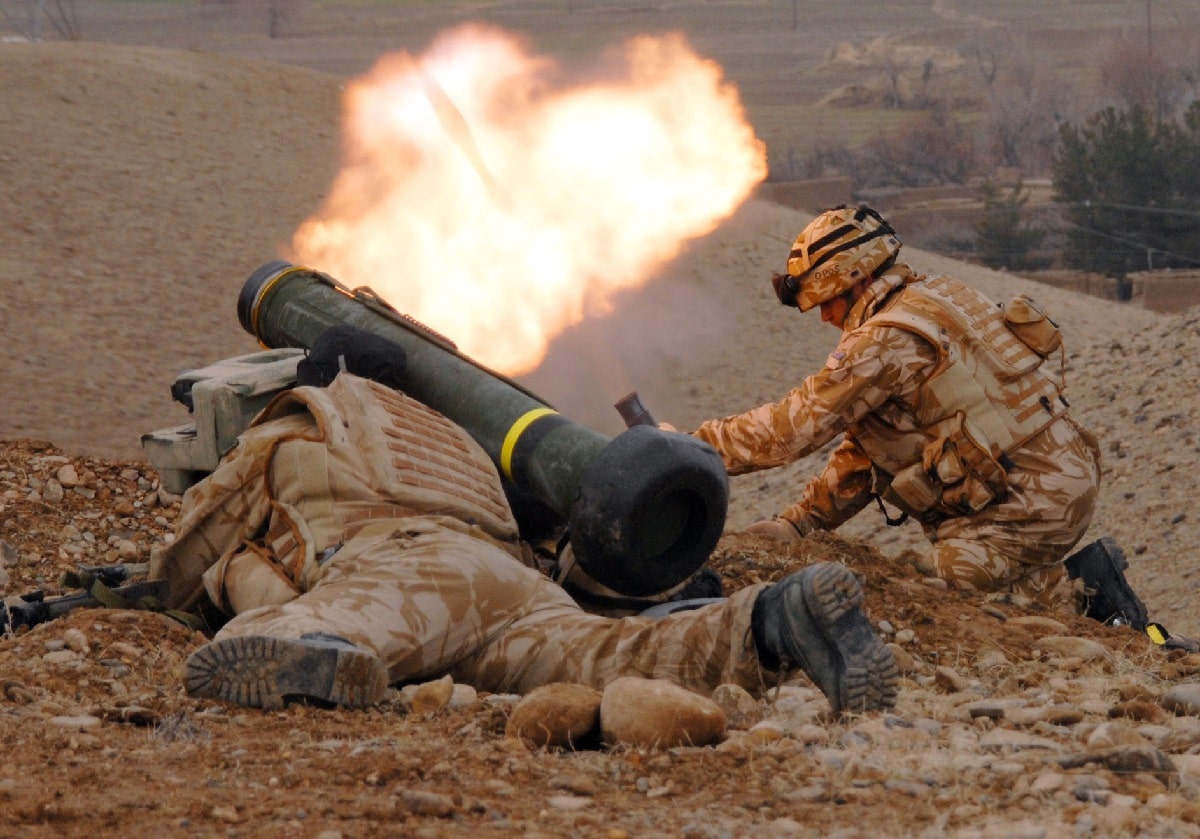Ph.D. Candidate Rob Lee, perhaps Twitter’s most prominent curator of Russo-Ukrainian battle footage, posted footage (see below) of a Javelin ATGM strike against a Russian tank. Ukraine’s 54th Mechanized Brigade has been credited with the strike. The tank was “possibly abandoned,” Lee pointed out. 1945 has not independently verified the authenticity of the footage.
In the clip, a soldier kneels, takes aim, and fires. The Javelin missile “soft-launches” – a method in which the missile ignites outside of the launching tube – then climbs into a top-attack trajectory, and finally plummets toward the stationary tank before making impact on the top of the vehicle (where the armor is thinnest).
What is the Javelin?
Made in America, the FGM-187 Javelin is an anti-tank guided missile. The Javelin has been in service for nearly thirty years, after debuting in 1996. The Javelin’s predecessor, the M47 Dragon was rudimentary by comparison. With the M47, the operator relied on a wire-guided tracking system, which was problematic – the system featured a simple wire that spooled behind the missile, essentially tethering the operator to the in-flight missile –requiring the operator to sit tight until the missile he launched made contact with its target.
The Javelin, on the other hand, is equipped with an infrared guidance system that tracks a target’s light emissions. The infrared guidance is a “fire and forget” device, which means the operator doesn’t have to sit tight while the missile tracks its target, he can instead elect to seek cover, should he so choose.
The Javelin uses two separate flight profiles. One, demonstrated in the recently posted footage, is the top-attack flight profile. In top-attack, the Javelin is able to attack armored vehicles from above, where their armor is generally the weakest.
In top-attack mode, the Javelin missile takes a sharp, climbing trajectory after launching – reaching a peak altitude of 490 feet. The second Javelin flight profile is the more “straight-forward” direct-attack mode. In direct-attack mode, the Javelin takes a relatively straight flight trajectory, reaching a peak altitude of only 200 feet.
Direct-attack is ideal for attacks against helicopters, obscured targets, and fortifications. A soft-launch is used for either flight profile.
Regardless of the flight profile, the Javelin delivers a high-explosive anti-tank (HEAT) warhead. The warhead is a shape charge device. A Shaped charge directs the effect of an impact’s energy. Where the HEAT warhead is concerned, the impact’s energy is directed so as to penetrate armor. With this purpose in mind, the HEAT warhead contains an explosive charge that collapses a metal liner that is housed inside the warhead. When the metal liner collapses, it creates a high-velocity superplastic jet, penetrating the enemy armor.
Video from Ukraine’s 54th Mechanized Brigade showing a Javelin ATGM strike on a Russian tank (possibly abandoned). https://t.co/5O84MicF8A pic.twitter.com/NzZ0YiP8Hv
— Rob Lee (@RALee85) May 15, 2022
Both the HEAT warhead, and the Javelin missile system, are very effective weapons – as Lee’s post suggests. Roughly 24 countries use the Javelin system, including Ukraine.
In 2018, Ukraine began receiving thousands of Javelin systems from the United States and NATO. Now forces to defend themselves from a Russian invasion, the Ukrainians are using those Javelin systems to kill hundreds of Russian tanks – and thousands of Russian armored vehicles. In fact, the Javelin has become an important symbol of Ukraine’s resistance. The image of “Saint Javelin” has proliferated. The image shows Mary Magdalene holding a Javeniline system.
Despite the Javelin’s venerable performance, observers are concerned with supply chain issues. The Center for Strategic and International Studies (CSIS) reports that the US has already included a substantial portion – nearly one-third – of its available Javelin missiles to Ukraine. However, the US likely lacks the production capacity to replenish the lent Javelins, and because Russian tanks outnumber the missiles available, the Javelin supply may soon be depleted.
Harrison Kass is a Senior Defense Editor at 19FortyFive. An attorney, pilot, guitarist, and minor pro hockey player, he joined the US Air Force as a Pilot Trainee but was medically discharged. Harrison has degrees from Lake Forest College, the University of Oregon School of Law, and New York University’s Graduate School of Arts & Science. He lives in Oregon and regularly listens to Dokken.

